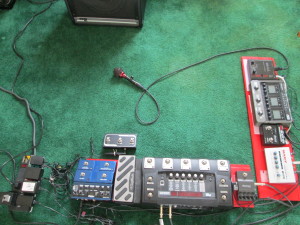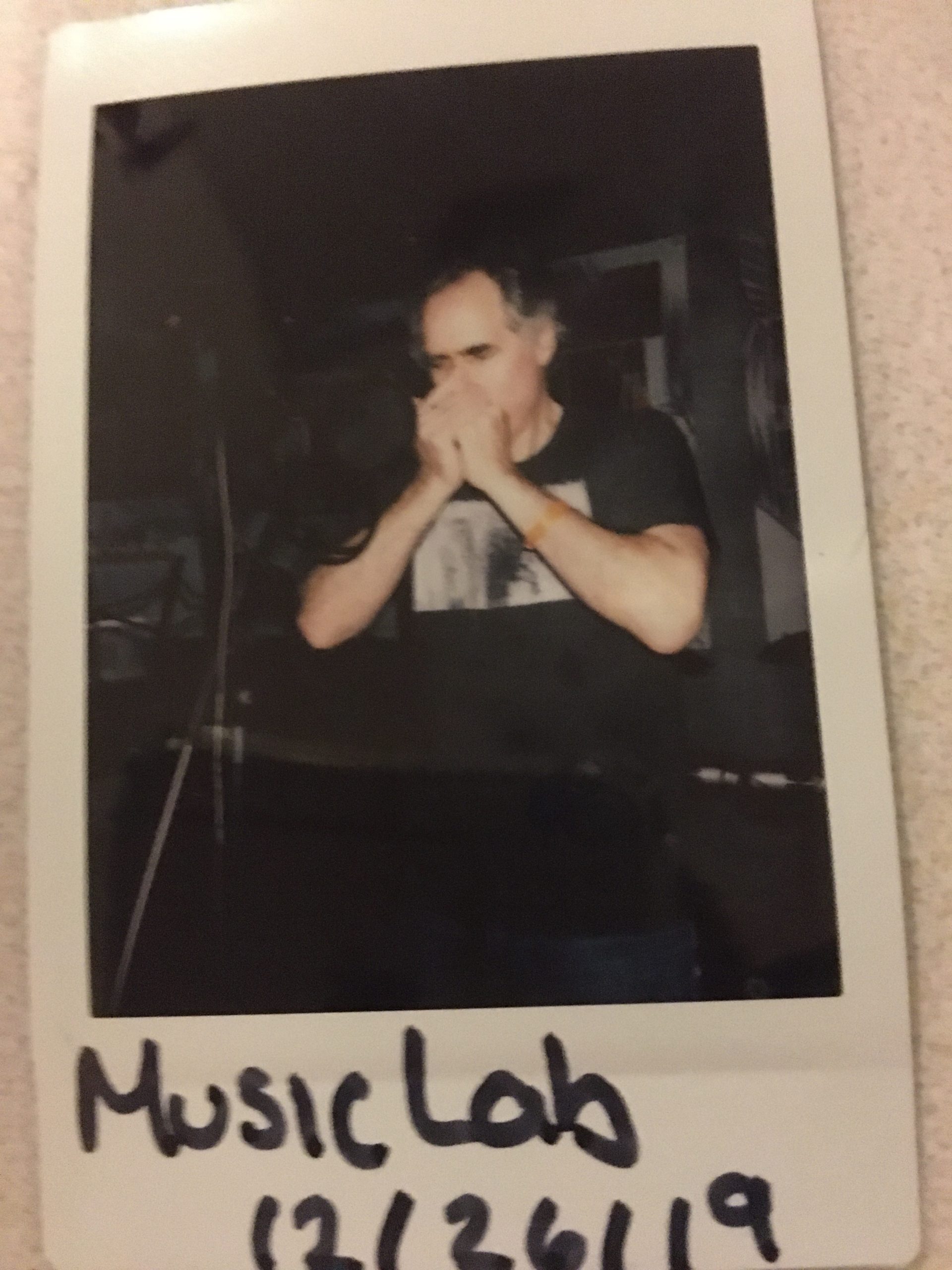
More on the Floor: Build Your Rig Piece by Piece Over Time
I said in a recent post that I had cleaned up my rig, reducing it to a few pieces: a Digitech iStomp running Swing Shift, a Digitech RP500, and a Digitech JamMan Stereo. Well, it wasn’t long before I completed the Zoom G3 patchset, and once I did that I wanted to combine the Zoom with the RP500. So my rig has expanded again. (Alas.) You can see the new rig in the picture.

The new stuff
As you can see, I’ve added a second board full of gear to the rig. The added board (the one on the right) includes, from left to right (actually top to bottom in the picture), an ART Tube MP preamp, a Zoom G3, a Radial Tonebone ABY, and a Nady 4×1 mixer. I added the preamp to the rig because I found that the iStomp sounded much better with the preamp in the chain. The Tube MP feeds the Radial ABY pedal, which lets me choose the RP500, the G3, or both for the signal path. The outputs from the RP500 and G3 are combined in the Nady mixer, which sends a mono signal to the JamMan Stereo looper. The looper output goes to a Peavey KB2 keyboard amp.
This is an amazingly flexible setup that can make sounds ranging from the simplest reverbs and delays, to traditional amped blues tones, to complex multi-layered tones that transform the harmonica’s weight and function.
What It All Costs
It’s also a very economical setup. The entire rig costs less new than a high-end harp amp like a Fender Bassman Reissue (not even including a mic), and it does a lot more. Here’s the breakdown with all prices new retail:
Fireball mic: $149
ART Tube MP: $40
Radial Tonebone ABY: $80
Zoom G3: $149
iStomp: $99
RP500: $300
Nady 4×1 mixer: $25
Jamman Stereo with FSX3 footswitch: $340
Peavey KB2: $260
Various 1/4″ cables (9): $100
TOTAL: $1525
As it happens, I bought a lot of this gear used, which I recommend because these pieces are built well, and the used ones tend to work. So here’s what it actually cost me (about a third less than retail):
Fireball mic: $125
ART Tube MP: $40
Radial Tonebone ABY: $80
Zoom G3: $80
iStomp: $55
RP500: $150
Nady 4×1 mixer: $25
Jamman Stereo with FSX3 footswitch: $240
Peavey KB2: $175
Various cables: $100
TOTAL: $1070
Where do you start with your own rig?
Many of the people reading this are thinking about the size and complexity of this rig, not to mention the price, and wondering what’s the entry price point for a modern setup. The good news is that you can easily build a complex setup over time, one piece at a time, with a nicely functional rig every step of the way.
The first thing you need is a mic, an amp modeler–either a Digitech RP or a Zoom G3 with my patch set installed–and an amp. The mic will run you $100-125 depending on what you buy; the amp modeler will run you $100-200, depending on which model you buy; and my patch set will run you $40-50, depending again on which amp modeler you choose. A decent keyboard amp will run you $200-250. That’s it–a pro setup for about $575 total, and that rig will enable you to play just about any kind of music that comes up, at volume, reliably. (And if you’ve already got a PA with an open channel in the room, you can skip the amp, which accounts for almost half the total cost, and just run the amp modeler straight to the PA.)
As time goes by, you can add pieces as needs and desires dictate. If it was me, the first thing I’d add is the looper. (That is in fact the firs thing I add to my super-stripped down performance setup of Digitech RP/Audix Fireball mic/Peavey KB2.) When you add a second amp modeler, that’s when you need a mixer, or a mixer plus an ABY pedal to switch rapidly between the modelers or combine them. The iStomp is the icing on the cake, and it’s very nice icing, given that you can choose from a range of free FX to load the thing. If you add an iStomp, or any other stompbox pedal, you probably want to add the Tube MP preamp or something similar too.
Start Simple and Build it Up
The basic principle here is to start with something simple, powerful, reliable, and economical, and build on it. Over time, the core of the rig–the Digitech RP–remains stable, so you can add elements over time without worrying about the foundation of your sound.
You may never want or need a rig that includes as many diverse elements as mine. Whether or not you do, this approach will ensure that your hard-earned money goes to gear that will make you sound good for a long, long time.
Tags In
Related Posts
5 Comments
Leave a Reply
You must be logged in to post a comment.
WHAT’S NEW
Categories
- Audio/Video
- Blog
- Blue Future
- Digitech RP Tricks and Tips
- Discography, CDs, Projects, Info, Notes
- Featured Video
- For the Beginner
- Gallery
- Hunter's Effects
- Hunter's Music
- Huntersounds for Fender Mustang
- Meet the Pros
- More Video
- MPH: Maw/Preston/Hunter
- My Three Big Contributions
- Player's Resources
- Pro Tips & Techniques
- Recommended Artists & Recordings
- Recommended Gear
- Recorded Performances
- Reviews, Interviews, Testimonials
- The Lucky One
- Uncategorized
- Upcoming Performances
- Zoom G3 Tips and Tricks

I prefer to combine analog and digital fx’s and to mix them or choose which one I prefer to use. I use for it Boss LS-2 Line Selector which works both as splitter and mixer (parallel or serial loop). But I prefer to operate by hand. It rather complex rig which allow me great variety of tones and it fits carry on baggage which is extremely importatnt for one band I play with.
https://pp.vk.me/c625421/v625421987/249a4/jkt5FZoBpoY.jpg
@Boris: sounds like a great rig (and it sounds like a great rig when I hear the stuff you’re doing with it, too). I agree that having physical dials to turn lets you make rapid changes in tone, and of course analog stuff sounds great. One of the reasons I like the RP500 is that it gives you LOTS of realtime control over the sound. But every piece of gear has its own sound, and no single piece of gear will give you every sound out there (at least within the current state of the (electronic) art. So many cool sounds, so little time…
https://youtu.be/rmEHEqBQ9jU?t=2h31m23s
Here I use clean tone G harmonica, then organ tone (100% wet Line6) from using LowD, then LwD solo using HarpBreak, then organ LowD again, that D harp solo using HarpAttack and then HarpAttack + Boss Harmonist as octave.